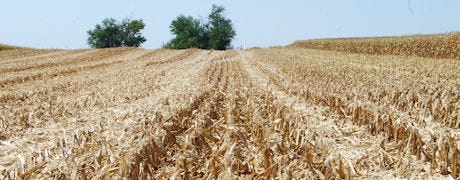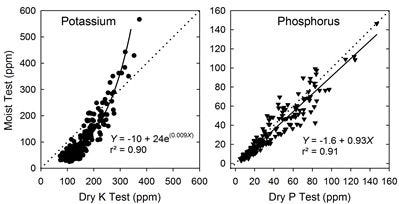October 8, 2012

A new private soil-testing laboratory began operations this fall in Iowa (based in Ames), and it tests for most nutrients using non-dried soil samples. This has generated many questions concerning the procedure and interpretations of test results because the common lab procedure for most nutrients is to dry and grind soil samples before testing them.

MOIST VS. DRY: A new private soil testing lab recently began doing business in Iowa and they test for crop nutrients using non-dried soil samples. "Attitudes about testing moist soil vs. dried soil samples have changed," says Iowa State University soil scientist Antonio Mallarino. "But you have to use the right sampling procedure and proper interpretation of the results."
The idea for testing non-dried soil samples is not new, explains Antonio Mallarino, Iowa State University agronomy professor and soil fertility specialist. It has been known for decades that drying soil may affect the extraction and measurement of certain nutrients, especially potassium or K. However, drying soil is commonly done by labs because it used to be a more practical sample handling procedure, and it standardizes soil moisture across all conditions.
Iowa State University research during the 1960s and 1970s, mainly greenhouse trials but some field trials, had shown that testing non-dried (field-moist) soil samples provided a better estimate of K fertilizer needs than testing dried samples, but both procedures provided similar estimates for phosphorus or P. Therefore, testing field-moist samples was adopted by the ISU soil and plant analysis laboratory, and it was the standard procedure for testing soil for P and K during the 1970s and 1980s.
Attitudes about handling and testing moist soil samples have recently changed

Figure 1. Comparison of amounts of soil K, P, and Mg extracted by the Mehlich-3 test from many soil samples taken from Iowa fields. The dotted diagonal line indicates an exact 1:1 ratio.
ISU discontinued the field-moist soil testing in 1988 (Mallarino was a graduate student at the time); not because it was a bad procedure but because no other lab adopted it and only ISU soil test interpretations were based on moist testing. The ISU lab made that decision even though Iowa research had shown the moist test was better for K, and it was among the tests recommended for the North-Central region by the NCR-13 committee (North-Central Regional Committee for Soil Testing and Plant analysis). Since ISU discontinued moist soil testing in 1998, the NCR-13 committee dropped the procedure from its soil-test methods publication.
~~~PAGE_BREAK_HERE~~~
"The general attitude about moist soil handling and testing changed considerably this year, when the private lab that began operations in Iowa developed a machine that easily handles moist samples and makes implementation of this procedure as practical as the common dry method. Or even more practical because it avoids drying and grinding samples," says Mallarino. "This laboratory has been conducting soil testing research with Iowa soils since last year, some in collaboration with ISU."

Figure 2. Relationship between the relative yield response of corn and soybean and soil-test K measured from dried and moist soil samples (ammonium-acetate test, 6-inch sampling depth). VL, very low; L, low; O, optimum; M, medium; H, high; VH, very high.
Field research conducted during the 1990s showed much variability and uncertainty with K soil testing due to several reasons. "So a portion of research my graduate students and I conducted since the early 2000s has focused on studying again if testing field-moist soil samples for K is better than testing dried samples," he says.
What the updated ISU research shows for testing moist vs. dry soil samples
The amount of extracted K is lower for the moist test than for the dry test at values usually optimum for crops or lower, but the difference decreases as levels increase, notes Mallarino. At extremely high levels, the moist test values can be higher than the dry test values. However, the moist and dry tests result in approximately similar values for P (by the Bray-1, Olsen, or Mehlich-3 methods), calcium (Ca) and magnesium (Mg) (by the ammonium-acetate or Mehlich-3 methods), pH, and buffer pH (by the SMP or Sikora methods). Figure 1 shows, as an example, comparisons for K and P extracted by the Mehlich-3 method from moist and dry samples.
Results from more than 300 field-response trials for corn and soybean confirmed that the field-moist test for K is better. Figure 2 shows the relationship between soil K measured by moist or dry tests and the relative yield response of corn and soybean to K fertilization. The graph for the dry test shows the current ISU interpretations for K, and further information including recommended fertilization rates is available in Extension publication PM 1688, A General Guide for Crop Nutrient and Limestone Recommendations in Iowa. The graph for the moist test shows the interpretations that ISU suggested for this test in the late 1980s. The fertilizer rate recommended for the Medium class used at the time was the amount to maintain soil-test values based on K removal, which in concept is similar to current Optimum class for the dry test. The old moist test classes relate to the recent yield responses almost exactly as they related to yield responses from research conducted during the 1980s (not shown).
~~~PAGE_BREAK_HERE~~~
Additional information and results will be presented at the North-Central Extension-Industry Soil Fertility Conference in Des Moines (November 14-15, 2012), the ISU Extension Integrated Crop Management Conference in Ames (November 28-29), and other ISU Extension conferences and workshops during the coming winter.
This fall the NCR-13 regional committee will publish an updated sample preparation chapter of the soil-test methods publication that includes the moist procedure, says Mallarino. The ISU interpretations and fertilizer recommendations for the moist test will be developed in the future, as results for several ongoing field trials become available and can be merged with previous results. Interpretations for the moist test for P using Bray, Olsen, and Mehlich-3 (colorimetric or ICP procedures) should be similar to those for the dry test, since data already showed similar test results. The interpretations for the moist test for K likely will be similar to those suggested by ISU in the 1980s.
You May Also Like




